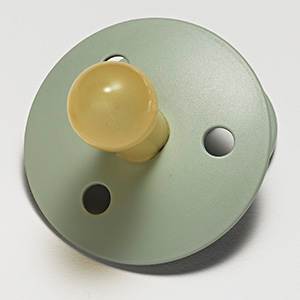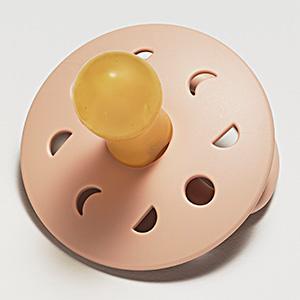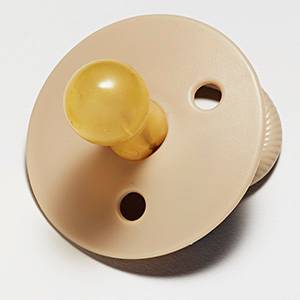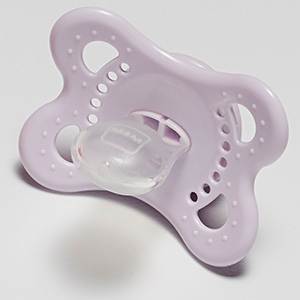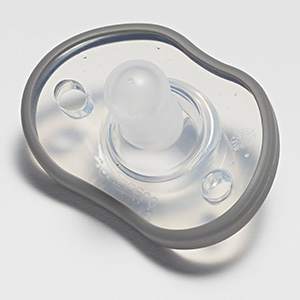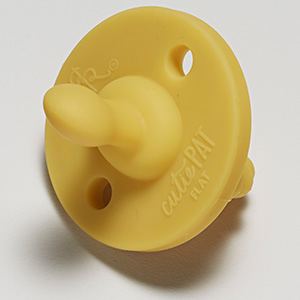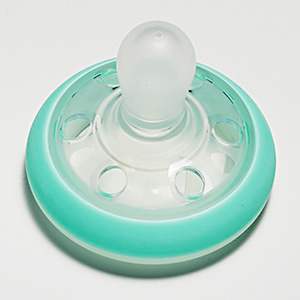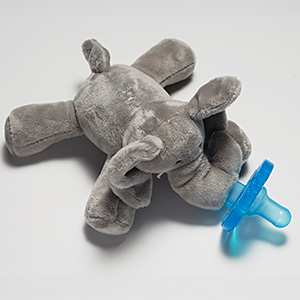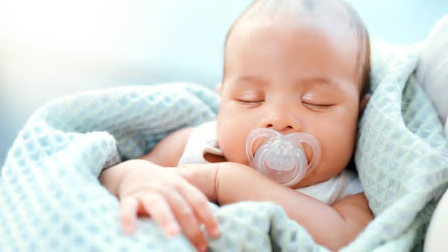We Analyzed, Boiled, Stretched, Poked, and Squeezed 20 Pacifiers for Hazards and Harmful Chemicals
And we have some very good news for stressed-out parents
When you shop through retailer links on our site, we may earn affiliate commissions. 100% of the fees we collect are used to support our nonprofit mission. Learn more.
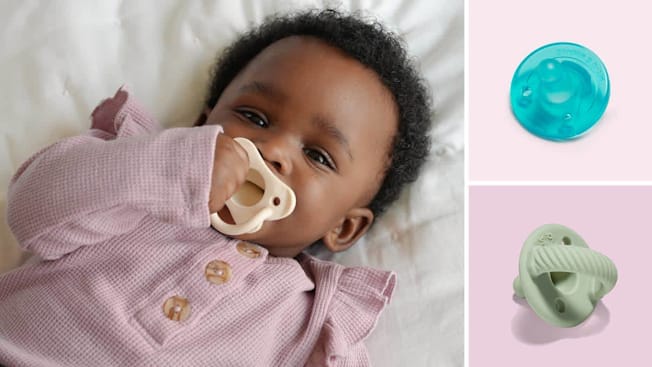
There never seems to be an end to worrying when you’re a parent. Whether the anxiety of the day is dangerous toys, lead and arsenic in baby formula, or potentially harmful chemicals in products like baby bottles, it can feel like keeping an eye out for danger is a parent’s second job. But brace yourself for some good news.
CR is happy to take one worry off your plate: Our team of scientists recently tested 20 brand-name and store-brand baby pacifiers for potentially dangerous chemicals and choking hazards. We used the federal pacifier safety standard as our blueprint and developed original, rigorous testing that included chemical testing for contaminants such as lead, nitrosamines, bisphenol S, and phthalates, as well as physical testing to ensure the pacifier’s guard, shield, nipple, and handle could withstand strong tensile forces without breaking, detaching, or posing a choking hazard.
Pacifier Testing
Consumer Reports conducted rigorous, independent testing on 20 pacifiers to check for contaminants like lead and nitrosamines, and structural flaws that could pose choking risks to babies.
CR’s Year of Pacifier Testing
CR’s scientists spent an entire year thoroughly testing pacifiers in our independent labs for potentially hazardous chemicals and physical defects that could pose safety risks to babies. A chemical analysis was also conducted on the nipples of 20 pacifiers intended for babies ages 0 to 6 months. Our goal wasn’t simply to evaluate whether the contaminant levels of lead, nitrosamines, bisphenols, and phthalates were compliant with standards, but to look for levels of contaminants that were even lower than those standards.
An analysis of incident reports posted from 2014 to 2024 on the Consumer Product Safety Commission’s public consumer safety database, SaferProducts.gov, revealed 178 specific pacifier-related incidents, with one reported death, 62 injuries, and 115 non-injuries. These statistics reinforced the need for CR to also test each pacifier’s physical limitations. We evaluated the pacifiers’ guard/shield performance, structural integrity, and choking hazards, and bite tests were performed on each nipple. See “How We Tested Pacifiers,” below, for more information on how chemical and physical tests were performed.
CR’s product safety experts also conducted an age-grading evaluation, comparing the age recommendations provided online with those labeled on the product, to determine whether pacifiers were being labeled and marketed consistently by the manufacturers.
How Safe Is Your Baby's Pacifier?
We talked to experts about tips for where to buy and not buy, what to know about pacifiers and breastfeeding, and how pacifiers may impact your child’s future teeth.
Chemical Test Results
All 20 pacifiers were tested for total lead, nitrosamines, bisphenol S, and phthalates. All were found to have levels well below CR’s most rigorous limits for these chemicals. “All pacifiers we tested had levels well below CR’s strict limits—good news for parents concerned about chemical exposure,” says Ashita Kapoor, CR’s associate director of product safety. “It’s also a great reminder that federal safety rules for children’s products are effective ways of reducing exposure to unnecessary risks from contamination.”
While all pacifiers sold in the U.S. are subject to strict safety regulations, unsafe pacifiers can and do enter the marketplace, as our pacifier safety investigation shows. Consumers can choose from the products listed in our chart below, which represent a significant share of the U.S. market and have performed well in our tests.
Physical Test Results
None of the pacifiers posed choking or strangulation risks in our physical tests, and all passed our structural integrity tests (when heavy force was applied to their nipples, shields, and handles, no parts broke or detached). No issues were reported for four of the 20 pacifiers we tested for bite force tests. Three natural rubber pacifiers achieved excellent results when tested under the maximum applied bite force: the Itzy Ritzy Soother, Bibs Pacifiers, and Frigg Natural Rubber Baby Pacifier. Silicone pacifiers weren’t as strong as rubber; our highest performing silicone pacifier in the bite test was the Nuk Timeless Comfy Pacifier.
Pacifier Bite Tests
CR tester José Amézquita performed structural integrity tests on pacifiers, including bite tests that measure how much tensile force each can withstand. All pacifiers withstood an adult’s bite force, but a few—especially three with natural rubber nipples—proved strongest, remaining intact under maximum pressure.
One potential issue that CR tester José Amézquita found when testing pacifier nipples was that seven of them retained water that was difficult to drain from the nipple hole. “Water retention can facilitate mold and bacteria growth inside a nipple, and while some manufacturers recommend pinching the nipples to remove the water, this may not remove all the water, and certain models may be unlikely to fully air dry,” Amézquita says. “Models with open nipples may not have that problem.”
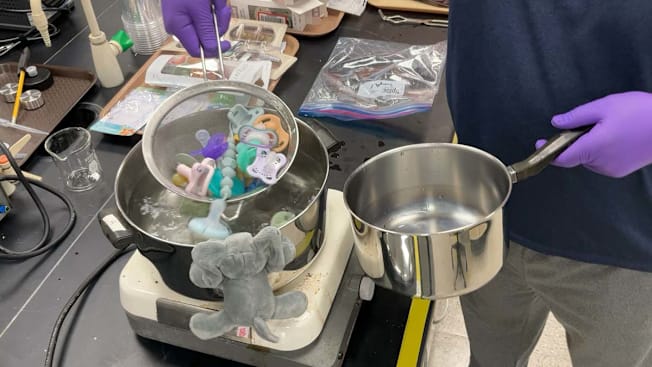
Photo: Consumer Reports Photo: Consumer Reports
To be safe, Philips Avent recommends washing your hands, holding the pacifier with the nipple facing up, and squeezing the nipple with your thumb and forefinger while shaking it lightly to eject any remaining water.
Pacifier Label Evaluation
While most pacifiers had clear labels, a few had labeling or age-grading discrepancies. Although this may seem like a minor issue, CR’s stance is that parents should never have to do their own research when it comes to pacifier labels or guess whether pacifier attachments, such as those made to resemble stuffed animals, are safe. Incident reports have tied the popular WubbaNub, for example, a plush-and-pacifier combo, to a hazardous sleeping environment risk, and it is recommended for use only when babies are awake. (Safe sleep guidelines from the American Academy of Pediatrics recommend no plush or soft items in your baby’s sleep area, to avoid the risk of suffocation.)
On its company website, WubbaNub states: “WubbaNub pacifiers can be used under observed napping and awake sucking. We’re advocates for safe sleep as recommended by the American Academy of Pediatrics and the Consumer Product Safety Commission. For extended overnight sleep, use a pacifier without the plush, such as our WubbaNub branded pacifier.” However, CR’s testers found that its package does not feature the same claims. We believe this safety warning should be prominently displayed on the package, where parents can easily see it.
CR contacted WubbaNub to request adding the warning to their packaging, and the company indicated that it is willing to do so: “We understand the importance of clear messaging at the point of purchase. While this warning is currently featured on our website, we are open to reviewing and incorporating additional messaging into future packaging updates.”
In an ideal world, all pacifier manufacturers would include clear and consistent age grading; warnings about checking for rips, tears, or damage; and expiration dates on their labels. But the only labeling standard required is the following warning on the individual packaging and on any retail display containing two or more pacifiers: “Warning—Do Not Tie Pacifier Around Child’s Neck as it Presents a Strangulation Danger.” This warning must appear “legibly” and “conspicuously.”
Most of the pacifiers we tested featured this warning label correctly. Four of them—Bibs, Itzy Ritzy Soother, Shein, and Sweet Child pacifiers—had the warning, but it was written incorrectly, in our experts’ judgment. And Ryan & Rose Cutie Pat Flat Pacifier was missing the CPSC’s mandatory warning statement about strangulation risk on its label. CR contacted Ryan & Rose, which responded, “Our current flat single packaging already includes the full verbiage. While the 10 packs did contain the line ‘Do not tie around a child’s neck,’ they were missing the added clarification ‘as it presents a strangulation danger.’ We are updating the flat 10 packs to ensure everything is consistent, and in the meantime, we will add stickers with the complete wording on all 10 packs going forward.”
How Unsafe Pacifiers Can—and Do—Enter the Market
While pacifiers are subject to strict safety regulations, unsafe pacifiers are easier to find than you might think. Here’s what to know about shopping for safe pacifiers for your baby.
Accurate age grading is important because a pacifier that is too small can be a choking hazard for an older baby, and a pacifier that is too large may also pose a choking hazard for a newborn. Purchasing a pacifier that is just right for your baby’s age is crucial. Of the 20 pacifiers CR reviewed, 10 had consistent age grading online and on the product, six did not mention age grading on the product, despite having it online, three showed conflicting age information between online listings and product labels, and one did not mention age grading online but had it on the product.
CR believes that pacifier manufacturers should be required to provide consistent age grading online and on packaging, as well as additional information on labels, including expiration dates and specific details on when to toss your paci (such as any sign of breakage or discoloration), care and cleaning instructions, and safety tips, including how to sanitize nipples to kill germs for infants under 6 months, and the importance of never tying a pacifier to a child’s crib or around their neck or hand.
“Parents already have enough to worry about, and shouldn’t be left guessing how their baby can use a pacifier safely,” says Gabe Knight, CR’s senior safety policy analyst. “At a minimum, every pacifier manufacturer should provide consumers with manufacture and expiration dates, and clear guidance on safe use, age grading, and cleaning. In the meantime, it’s important for parents to regularly check a pacifier for tears, cracks, breakage, and mold, and to never attach a pacifier around a baby’s neck, which can pose a serious strangulation risk.”
Pacifier Test Results
The 20 pacifiers we tested for dangerous chemicals and durability performed well in our evaluations. Pacifiers are listed alphabetically below.

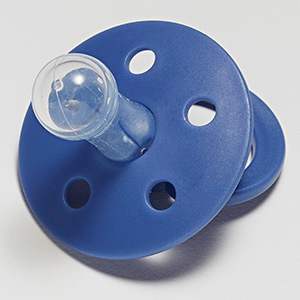
How We Tested Pacifiers
Let’s break down the specifics on CR’s rigorous chemical and physical testing.
Chemical Tests
• Nitrosamines: We tested for nitrosamines (which may be linked to cancer) using a lab method called gas chromatography with mass spectrometry. This followed the European safety standard BS EN 12868:2017.
• Lead: We measured lead levels in each pacifier using a modified version of Environmental Protection Agency Method 6020B, which detects trace metals.
• Phthalates: We tested for these chemicals (a number of which have been shown to be endocrine-disrupting chemicals) using a rigorous test called Gas Chromatography–Mass Spectrometry (GC-MS).
• Bisphenol S: Similar to phthalates, bisphenols may be endocrine-disrupting chemicals. We tested for them using the accurate Liquid Chromatography-Mass Spectrometry, while following a 2013 published scientific method from the Journal of Chromatography A.
Physical Tests
• Guard or shield requirements: We pushed each pacifier nipple through an opening the size of a baby’s mouth while pulling with a 2-pound force for 10 seconds. To pass this test, no part of the guard or shield should pass through the opening.
• Structural integrity: We tested the strength of each pacifier’s nipple, shield, and handle using 2- and 10-pound forces before and after heating and cooling the pacifier parts. The pacifiers should not break or come apart during the tests.
• Bite resistance: We wanted to know how resistant each pacifier was to biting. Lower resistance to biting can make pacifiers more prone to breaking inside a child’s mouth and creating a choking hazard. We pressed a spearlike rod against the side of each pacifier’s nipple until it either punctured or reached 140 pounds of force. There is no official standard for pacifier bite tests, and there is limited data on children’s bite force; CR is a leader in these tests.
• Ribbons, strings, or other attachments: We pointed out which pacifiers are sold with attachments that may pose a strangulation risk.

















